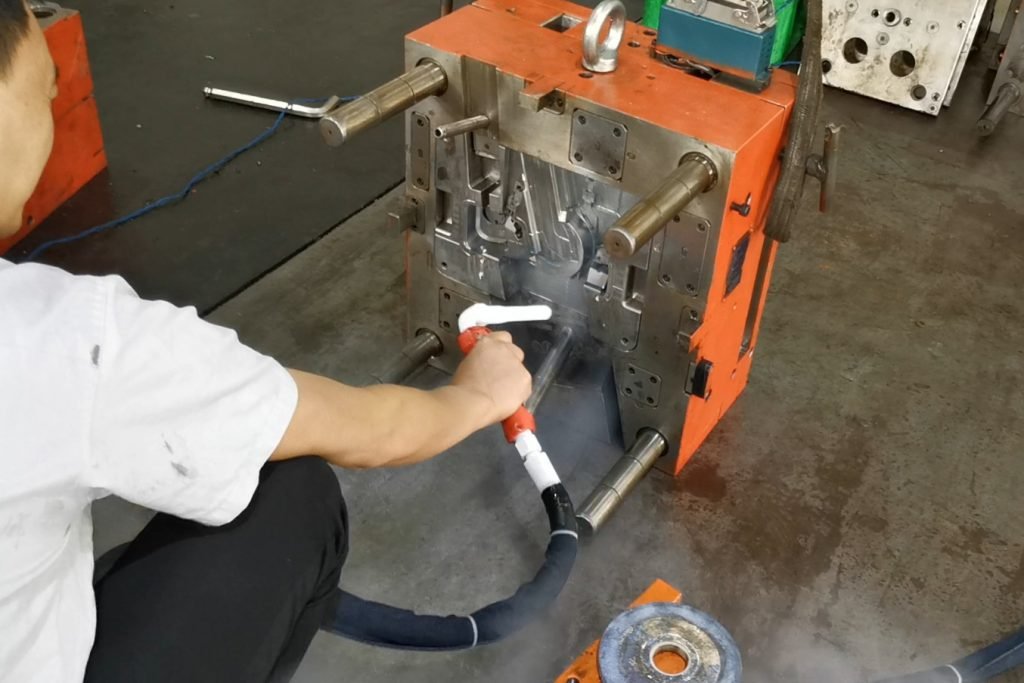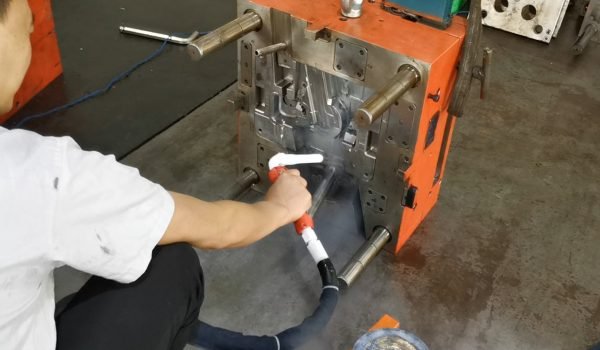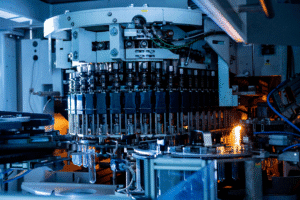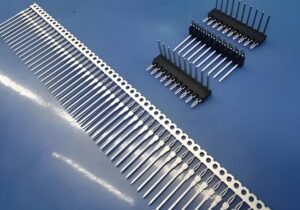Keeping injection molds clean is key to making high-quality plastics. If you ignore mold care, you might face lower product quality and more downtime. It’s vital to use good mold cleaning methods to avoid these problems and keep production running smoothly.
Good mold care means cleaning and checking them often to stop dirt and debris from building up. By doing this, makers can make their molds last longer, cut down on defects, and boost product quality. Knowing how important mold care is and sticking to a cleaning routine can help businesses run better and make more money.
Importance of Clean Injection Molds
Regular plastic mold cleaning is key for top-notch injection molding. Clean molds help make high-quality products, cut down on defects, and save time. The importance of mold care is huge, as it affects the mold’s performance and life span.

Some key benefits of clean injection molds include:
- Enhanced product quality: Clean molds mean products without flaws, leading to better quality.
- Reduced defects and downtime: Cleaning often stops costly repairs or replacements, cutting down on waste.
- Increased mold lifespan: Good plastic mold cleaning and care can make molds last longer, saving on replacements.
By focusing on importance of mold care and cleaning regularly, makers can boost their injection molding. This leads to better productivity overall.
Understanding the value of clean injection molds is key. By using good plastic mold cleaning methods, makers can make top-quality products. This also helps cut costs and downtime.
Types of Injection Molds
It’s important to know the different types of injection molds. This knowledge helps choose the right cleaning method and materials. Each mold type has its own design and function, needing a specific cleaning approach.
When looking at injection mold types, several factors matter. These include the runner system type and design complexity. Hot runner molds and cold runner molds are two main types, each with its own benefits and drawbacks. The mold design depends on the application and desired outcome.
Hot Runner vs. Cold Runner Molds
Hot runner molds are best for high-volume production and complex designs. They have a heated runner system for faster cycle times and more productivity. Cold runner molds, simpler in design, are used for lower-volume production.
Complex vs. Simple Designs
Complex mold designs need more detailed cleaning methods. Simple designs can be cleaned with easier methods. The mold design affects the choice of cleaning materials and methods for effective cleaning. Knowing about different molds helps manufacturers clean better and work more efficiently.
Common Contaminants Found in Injection Molds
Injection molds often face various contaminants that can harm the quality of the final product. Mold contaminants can come from the manufacturing, storage, or maintenance of the molds. It’s key to find and fix these contaminants to make sure products are of high quality.
Common contaminants include plastic residue, dust and debris, and rust and corrosion. To remove these, different cleaning solutions and methods are used. The right cleaning method depends on the contaminant and the mold material.
- Plastic residue: can be removed using solvents or ultrasonic cleaning
- Dust and debris: can be removed using compressed air or vacuum cleaning
- Rust and corrosion: can be removed using chemical cleaning solutions or abrasive materials
Keeping injection molds clean and well-maintained is vital. It stops contaminants from building up and ensures products are of high quality. By picking the right cleaning solutions and methods, manufacturers can make their molds last longer and reduce downtime.
The choice of cleaning solution and method must match the mold’s needs and the manufacturing process. Knowing the common contaminants in injection molds and using the correct cleaning solutions helps manufacturers improve their production and product quality.
| Contaminant | Cleaning Solution | Technique |
|---|---|---|
| Plastic residue | Solvents | Ultrasonic cleaning |
| Dust and debris | Compressed air | Vacuum cleaning |
| Rust and corrosion | Chemical cleaning solutions | Abrasive materials |
Preparing for Mold Cleaning
Before starting the mold cleaning process, it’s key to take safety precautions to protect everyone. This means more than just getting cleaning solutions. It’s about careful planning and detail.
First, you need to know what tools and materials are needed for safe cleaning. This includes gloves, goggles, and a well-ventilated area. Here’s a list of what you might need:
- Soft-bristled brushes for gentle scrubbing
- Mild detergents or specialized cleaning solutions
- Microfiber cloths for drying and polishing
By preparing well, you can make sure the cleaning is safe and effective. This means following safety precautions and using the right tools. It leads to a successful mold cleaning preparation.
Also, think about the type of mold and how bad it is. This helps you know the best way to clean it. It makes sure the cleaning fits the mold’s needs.
Cleaning Methods for Injection Molds
There are many ways to clean injection molds, each with its own benefits and drawbacks. The right method depends on the mold type, contamination level, and cleanliness needed. Common mold cleaning methods include manual cleaning, ultrasonic cleaning, and chemical solutions.
These methods can be used alone or together to get the mold clean. For example, ultrasonic cleaning is great for tough contaminants. Manual cleaning is better for delicate spots. Always choose the right method and follow safety rules to avoid mold damage or injury.
Ultrasonic cleaning is good because it can clean small areas well and is gentle. It’s perfect for detailed molds and sensitive surfaces. Plus, ultrasonic cleaning works with many cleaning solutions, making it flexible for different tasks.
Manual Cleaning Techniques
Manual cleaning uses brushes, cloths, and tools to clean the mold. It’s good for small spots or molds with complex designs.
Ultrasonic Cleaning
Ultrasonic cleaning uses sound waves to clean hard-to-reach areas and remove tough contaminants. It’s great for molds with complex designs or stubborn dirt.
Chemical Cleaning Solutions
Chemical cleaning uses chemicals to break down and remove dirt from the mold. It’s often used for molds with a lot of dirt or hard-to-remove residues.
Steps for Manual Cleaning
Manual cleaning is key to keeping injection molds in top shape. It’s important to follow a step-by-step guide for thorough and safe cleaning. Knowing the mold cleaning steps and executing them with care is essential.
The first step is to take apart the mold carefully to avoid damage. Then, scrub and wipe the mold to get rid of dirt and residue. Soft brushes and gentle cleaners are best to avoid scratches.
Disassembling the Mold
Breaking down the mold is a critical first step. It involves taking out the mold plates, cores, and cavities to clean hard-to-reach spots. This requires patience and a keen eye to ensure everything is removed correctly.
Scrubbing and Wiping
Scrubbing and wiping are vital steps to clean the mold. Use soft brushes and mild cleaners to remove dirt and residue. Ultrasonic cleaners can also help with tough spots, but always follow the instructions and safety guidelines.
Rinsing and Drying
The last steps are rinsing and drying the mold. Rinse it well with clean water to get rid of any leftover cleaners or dirt. Then, dry it with a soft cloth to avoid water spots and corrosion. By following these steps, your molds will stay in great condition and keep producing quality products.
| Manual Cleaning Steps | Description |
|---|---|
| Disassembling the Mold | Removing mold components to access areas that require cleaning |
| Scrubbing and Wiping | Using soft brushes and mild cleaning agents to remove contaminants and residue |
| Rinsing and Drying | Thoroughly rinsing and drying the mold surfaces to prevent water spots and corrosion |
Using Ultrasonic Cleaners
Ultrasonic cleaning is a strong method for getting rid of dirt from injection molds. It uses high-frequency sound waves to create a cleaning solution. This solution is both effective and gentle on mold surfaces.
This method is great for cleaning hard-to-reach areas of the mold. It’s perfect for complex designs.
The ultrasonic cleaning process has many benefits. It can remove dirt without harming the mold. This reduces downtime and makes the mold last longer.
To get these benefits, you need to follow the right steps. First, prepare the mold. Then, choose the right cleaning solution. Lastly, use the ultrasonic cleaner at the correct frequency and temperature.
Benefits of Ultrasonic Cleaning
- Effective removal of contaminants from tricky areas
- Gentle on mold surfaces, reducing damage risk
- Increases mold lifespan
- Reduces downtime and boosts productivity
By knowing the ultrasonic cleaning benefits and following the right steps, manufacturers can keep their molds clean. This leads to better quality products and more efficiency.
Chemical Cleaning Solutions
Chemical cleaning is key to keeping injection molds in top shape. It helps remove tough contaminants. Chemical cleaning solutions are made to tackle specific types of dirt, making them a big help in cleaning molds.
It’s important to pick the right mold cleaning chemicals for the job. You can use solvents, acids, or bases. Each has its own uses and must be used as directed by the manufacturer.
Recommended Chemicals for Mold Cleaning
- Solvents: Effective for removing grease and oil-based contaminants
- Acids: Useful for removing rust and corrosion
- Bases: Suitable for removing plastic residue and other organic contaminants
When using chemical cleaning solutions, follow the recommended steps for safety and best results. This means wearing protective gear and working in a well-ventilated area. By choosing the right mold cleaning chemicals and following the right steps, you can keep your molds in great shape and ensure they work well.
Regular Maintenance of Injection Molds
Keeping injection molds in good shape is key to making high-quality products. A good maintenance plan stops contamination, cuts downtime, and boosts efficiency. Regular care helps avoid expensive fixes and keeps product quality up.
To make a solid maintenance plan, think about these important points:
- How often you use the molds matters. More use means more cleaning needed.
- Complex molds need extra care because of their detailed designs.
- Different materials might need special cleaning methods.
For cleanliness, do regular checks, fix problems fast, and stick to a maintenance schedule. This way, you get better performance, less downtime, and higher quality products.
Establishing a Cleaning Schedule
Make your maintenance schedule fit your molds’ needs. Consider how often you use them, their complexity, and the materials. Regular maintenance and a good cleaning plan lower contamination risks, cut costs, and improve efficiency.
Troubleshooting Common Mold Issues
Mold problems can pop up even with regular upkeep, causing production delays and product quality issues. Finding the root cause is key to solving these problems quickly. Troubleshooting mold problems means looking for and fixing the main reasons behind them.
Mold damage, corrosion, and contamination are common issues. These problems can stem from poor upkeep, not cleaning enough, or harsh environments. Knowing the causes and having a plan to tackle them is vital.
Identifying Cleaning Problems
First, we need to spot cleaning problems. This means checking the mold for damage, corrosion, or contamination. A thorough visual check and contamination tests are necessary.
Solutions to Persistent Contaminants
To deal with persistent contaminants, we use cleaning and upkeep methods like ultrasonic and chemical cleaning. These methods help remove contaminants and stop them from coming back. Regular upkeep also helps prevent mold problems from starting.
Some common fixes for mold issues include:
- Regular cleaning and maintenance
- Ultrasonic cleaning
- Chemical cleaning
- Replacing damaged or corroded parts
Understanding mold issues and having a plan to fix them helps manufacturers keep production running smoothly. Troubleshooting mold problems is key to a productive and efficient process. Quick action can prevent bigger problems.
Troubleshooting mold problems is vital for a productive and efficient manufacturing process. Quick action on mold issues helps avoid downtime and ensures product quality. Regular upkeep and cleaning are key to preventing mold problems.
| Causes of Mold Issues | Effects of Mold Issues | Solutions |
|---|---|---|
| Poor maintenance | Downtime, product quality issues | Regular cleaning and maintenance |
| Inadequate cleaning | Contamination, corrosion | Ultrasonic cleaning, chemical cleaning |
| Harsh environments | Mold damage, corrosion | Replacement of damaged or corroded parts |
Environmental Considerations
Cleaning injection molds should consider the environment. Eco-friendly cleaning solutions help reduce mold maintenance’s environmental impact. Sustainable practices can protect our planet and make it healthier.
Using eco-friendly cleaning solutions is key to lowering environmental impact. This includes choosing biodegradable cleaners, using less water, and recycling waste. These steps help reduce harm to our planet.
Eco-Friendly Cleaning Solutions
- Biodegradable cleaning agents
- Water-based cleaning solutions
- Plant-based cleaning products
Waste Disposal Practices
Proper waste disposal is vital for the environment. Manufacturers should recycle and dispose of hazardous materials correctly. This follows all regulations to protect our planet.
Conclusion
Cleaning and maintaining injection molds is key for top-notch product quality. It helps cut down on defects and makes molds last longer. By sticking to cleaning practices and a cleaning schedule, manufacturers boost their molds’ efficiency. This leads to a smoother and cheaper production process.
Regular cleaning is vital. Ignoring mold cleanliness can lead to many problems. These include poor part quality, more downtime, and shorter mold life. By focusing on mold cleaning, manufacturers protect their investment. They also improve productivity and deliver quality products that meet customer expectations.
section>
FAQ
What are the benefits of maintaining clean injection molds?
Clean injection molds improve product quality and reduce defects. They also lower downtime and extend mold life. Regular cleaning prevents costly repairs or replacements.
What are the different types of injection molds?
Injection molds come in hot runner or cold runner types. They also vary in complexity. Knowing these differences helps choose the right cleaning method and materials.
What are the common contaminants found in injection molds?
Common contaminants include plastic residue, dust, and rust. Identifying these contaminants is key to picking the right cleaning solution.
What safety precautions should be taken when cleaning injection molds?
Wear personal protective equipment (PPE) and follow safety guidelines. Having the right tools and materials is also essential for safe cleaning.
What are the different cleaning methods for injection molds?
Cleaning methods include manual techniques, ultrasonic cleaning, and chemical solutions. Each method suits different molds and contaminants.
How can ultrasonic cleaning benefit injection mold cleaning?
Ultrasonic cleaning is effective for reaching small areas. It’s gentle and removes a wide range of contaminants.
What are the recommended chemicals for cleaning injection molds?
Solvents and detergents are recommended for mold cleaning. The choice depends on contaminants and mold material. Safety and effectiveness are key.
How can regular maintenance of injection molds be established?
Create a regular cleaning schedule and follow best practices. Routine inspections and quick issue resolution extend mold life.
How can common mold issues be troubleshooted?
Identify and address cleaning problems. Find solutions for persistent contaminants. This minimizes downtime.
What are the environmental considerations for injection mold cleaning?
Use eco-friendly cleaning solutions and follow waste disposal practices. This reduces environmental impact.




